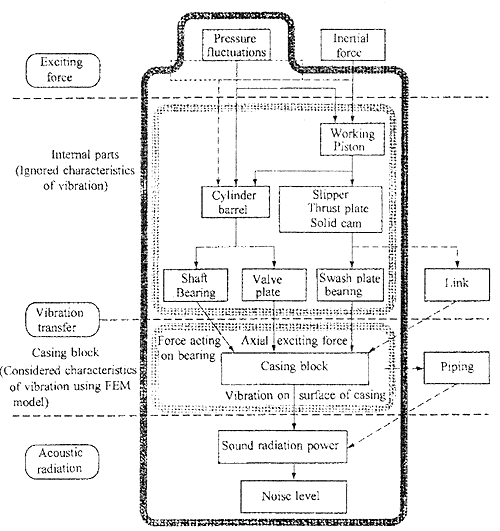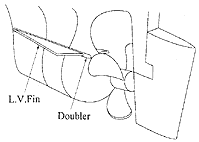The level of its noise is about 3.5 dB smaller than the current model. Fig. 7.2 shows the swash plate type axial piston pump of the subject of the study.

Fig. 7.2 Swash plate type axial piston pump
They group the noise sources into two classes. One is generated by the hydraulic causes of a cavitation, a pulsating pressure and so on. Another is generated by the mechanical causes of an unbalanced rotor, poor mounting of a base or piping, and so on. They consider the change of the pressure in the pump cylinder and the propagation of vibration, and make the model of the generation mechanism of the pump noise shown in Fig. 7.3. As a result, the following things were clear. The additional volume (dead space) of the cylinder improves the frequency characteristics of the exiting force due to pressure in it. On the propagation of vibration, the additional lib on the pump casing is able to reduce the noise of the structure. These results are gotten from both the calculation simulated by the above mentioned model and the experiment.

Fig. 7.3 Generation mechanism of pump noise
As mentioned above, they have developed the analyzing method of the exiting force due to pressure in the pump cylinder and its characteristics of the vibration propagation, and they applied this method to the current model, and they confirmed that the redesign of a pump casing brought to the pump reducing its noise.
7.3 Development of Energy Saving Device for Ships IHI-L.V.Fin3)
Ishikawajima-Harima Heavy Industries Co., Ltd. has developed the IHI-L.V.Fin (Low Viscous resistance Fin) which provides a simple and cost-effective mean of propulsion energy saving. Fig. 7.4 shows a sketch of the IHI-L.V.Fin. As shown in this figure, the L.V.Fin consists of a pair of flat triangular fins mounted on the stern upstream of the propeller, and it can be welded simply. Model experiments have proved that the Fin smoothed the water flow around the stern of a ship effectively, recovered the pressure on the surface of a ship hull and consequently reduced viscous resistance. Thus fin's performance is influenced by its dimension and position. It was optimized through the model experiments and the CFD (Computational Fluid Dynamics) method. As a result, it was clearly that the power saving obtained with the L.V.Fin was 2 to 3 percent for a full ship. About 20 ships have already been mounted with L.V.Fin. They have been put under an obligation of the energy saving.

Fig. 7.4 Sketch of IHI-L.V.Fin
7.4 Development of Dynamic Simulator for Absorption Refrigerator4)
Recently, absorption refrigerators have attracted much attention in the section of a large capacity refrigerator because they do not use FRON as the refrigerant. However, an absorption refrigerator consists of many heat exchangers and contains a lot of solution and refrigerant. Therefore, it has a large heat capacity and takes a long time to start, stop and change the cooling load.
BACK CONTENTS NEXT